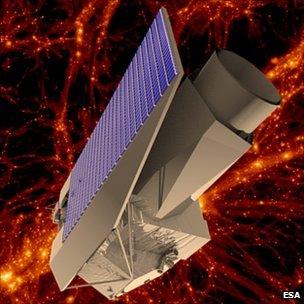Survey gets a grip on dark energy
- Published

BOSS data is acquired by the 2.5m Sloan telescope at Apache Point Observatory
Astronomers have measured the precise distance to over a quarter of a million galaxies to gain new insights into a key period in cosmic history.
The 3D map of the sky allows scientists to probe the time six billion years ago when <link> <caption>dark energy</caption> <url href="http://www.bbc.co.uk/science/space/universe/questions_and_ideas/dark_energy" platform="highweb"/> </link> became the dominant influence on the Universe's expansion.
No-one knows the true nature of this repulsive force, but the exquisite data in the international <link> <caption>BOSS survey</caption> <url href="http://www.sdss3.org/surveys/boss.php" platform="highweb"/> </link> will help test various theories.
The analysis appears in six papers.
These have all been posted <link> <caption>on the arXiv preprint server</caption> <url href="http://arxiv.org/abs/1203.6594" platform="highweb"/> </link> .
"This is an incredibly exciting time to be working in cosmology, and we're all privileged to be part of the Baryon Oscillation Spectroscopic Survey (BOSS)," said Prof Will Percival from the University of Portsmouth - a UK member of the international research group.
"What we've done is measure the 3D positions for just over 250,000 galaxies, covering the largest volume of the Universe ever surveyed. That gives us an amazing map that we can then analyse to try to understand how and why the Universe's expansion is accelerating," he told BBC News.
Prof Percival was speaking here in Manchester at the <link> <caption>UK National Astronomy Meeting (NAM)</caption> <url href="http://www.jodrellbank.manchester.ac.uk/meetings/nam2012/" platform="highweb"/> </link> .
Preferred separation
The discovery that everything in the cosmos is moving apart at a faster and faster rate was <link> <caption>one of the major breakthroughs of the 20th Century</caption> <url href="http://www.nobelprize.org/nobel_prizes/physics/laureates/2011/" platform="highweb"/> </link> .
It went against all preconceptions. Up until the discovery, it was thought the Universe's expansion would most likely have been decelerating under the influence of gravity.
Scientists now find themselves grasping for new physics to try to explain what is going on.
BOSS is intended to support that effort.
Will Percival: Acquiring the data is a painstaking process
It uses two techniques to understand the acceleration.
One concerns so-called <link> <caption>baryon acoustic oscillations</caption> <url href="http://en.wikipedia.org/wiki/Baryon_acoustic_oscillations" platform="highweb"/> </link> . These are pressure-driven waves that passed through the very early Universe and which were imprinted on the distribution of matter once conditions had cooled below a certain point.
Today, these "wiggles" show themselves as a preferred scale in the separation of galaxies and can be used as a kind of standard ruler to measure the geometry of the cosmos.
"Because you can trace this pattern all the way through the Universe, it tells you a lot about its content," explained Portsmouth's Dr Rita Tojeiro.
"If it had a different content - it had more matter, or it had less matter, or it had been expanding at a different rate - then you'd see a different map of the galaxies. So, the fundamental observation is this map."
Einstein 'right'
The other technique being used by BOSS involves "redshift space distortions". These describe the component in the velocity of galaxies that stems from the growth of structure in the Universe. The team can see if neighbouring galaxies are clustering in a way that would be expected from the action of gravity.

Euclid should launch in 2019
"What we find is everything is very consistent with Einstein's theory of general relativity, coupled with the cosmological constant that he put into his equations. He put it in originally to make the Universe static, and then took it out," said Prof Percival.
"But if we put the constant in with the opposite sign, we can get acceleration. And if we do that, we find equations that are perfectly consistent with what we're seeing."
The quality of the BOSS map is big step forward on all previous such surveys.
It provides details on the position of galaxies out to some six billion light-years from Earth and gives those measurements to within 1.7% of their expected true value.
This is particularly significant in the context of understanding dark energy because six billion years ago is the period when the repulsive force becomes the dominant action in driving the expansion of the Universe, and gravity takes a back seat.
Space mission
The BOSS project, which acquires all its data using the <link> <caption>2.5m Sloan telescope at Apache Point Observatory</caption> <url href="http://www.sdss.org/background/site.html" platform="highweb"/> </link> in New Mexico, is only a third complete and will continue to map the 3D positions of galaxies.
"We use these measurements to test a whole bunch of theories to try to understand dark energy a little bit better," Dr Tojeiro told BBC News.
"The better your measurement, the more discriminant power you have between those competing theories. And if we can get an even greater volume of galaxies then we can start to perform new and different tests."
The European Space Agency is also planning to take the BOSS approach into orbit with its <link> <caption>Euclid mission</caption> <url href="http://www.bbc.co.uk/news/science-environment-15180497" platform="highweb"/> </link> , which should launch towards the end of the decade. Portsmouth researchers will be playing key roles in the space mission, also.
Euclid will measure the precise positions of 50 million galaxies out to some 10 billion light-years from Earth.
This means it will witness the full evolution of dark energy's influence on the expansion, from minimal relevance at the earliest epoch to its overriding control in modern times.
Jonathan.Amos-INTERNET@bbc.co.uk and follow me on <link> <caption>Twitter</caption> <url href="https://twitter.com/#!/BBCAmos" platform="highweb"/> </link>
- Published11 January 2012
- Published5 October 2011
- Published4 October 2011
- Published19 May 2011